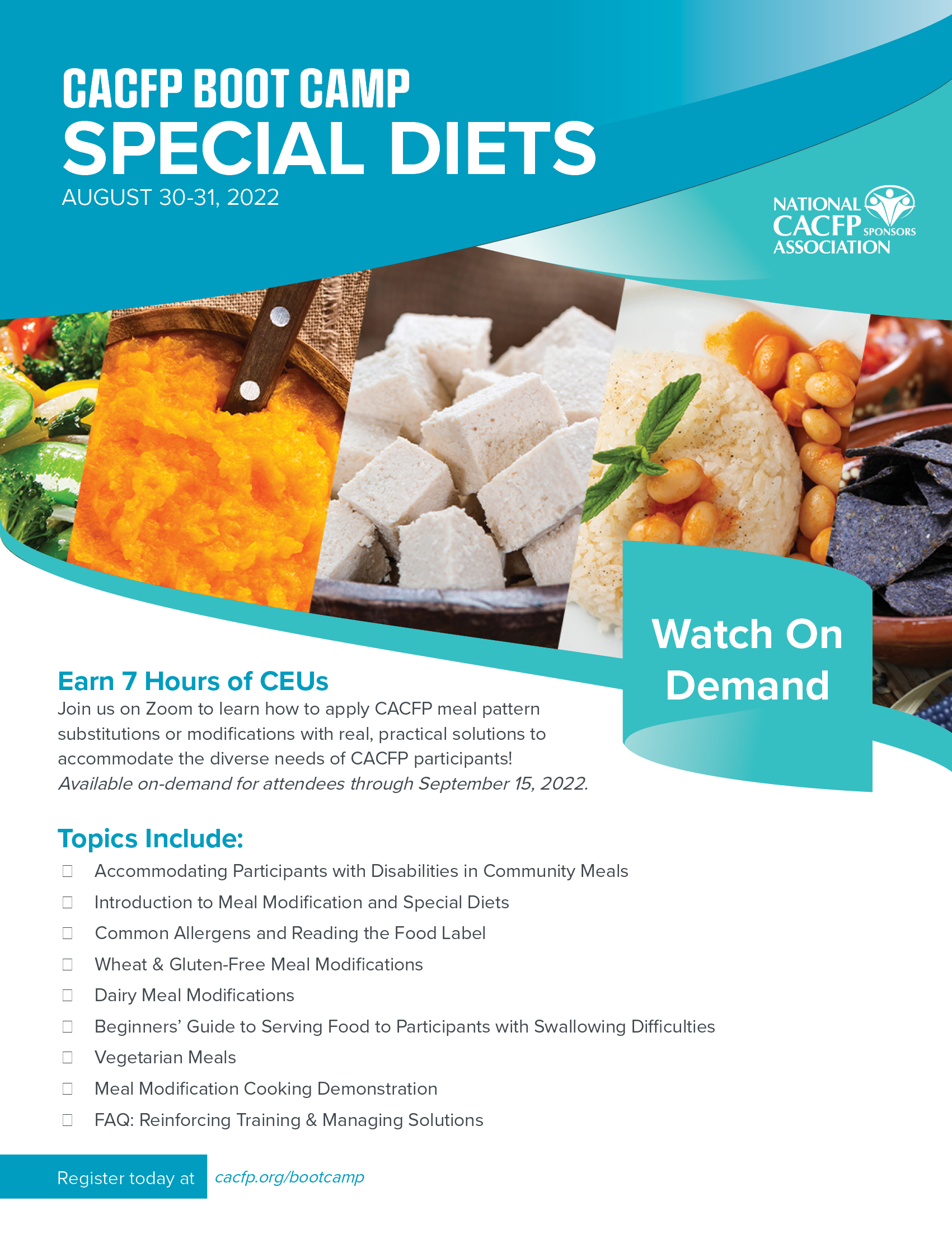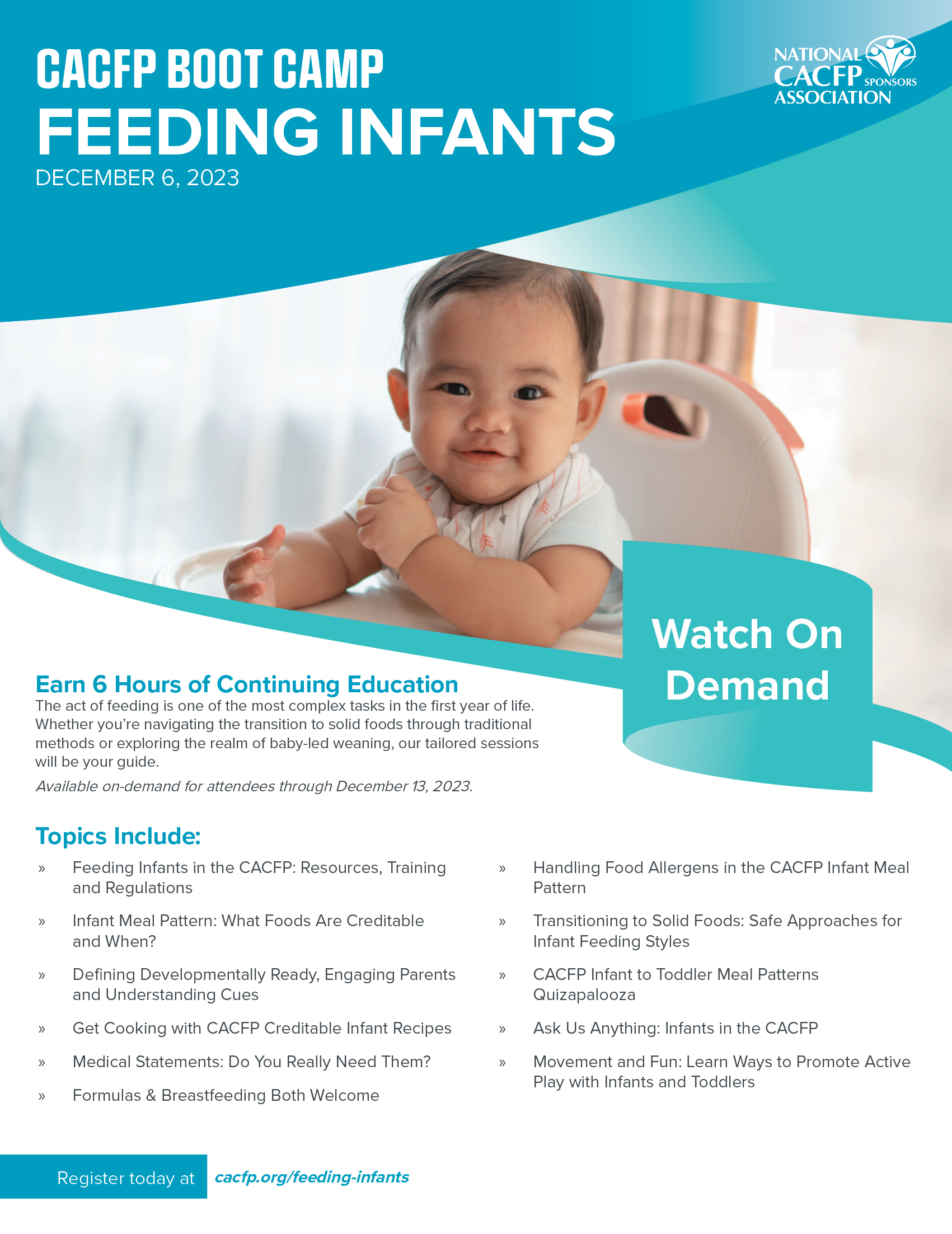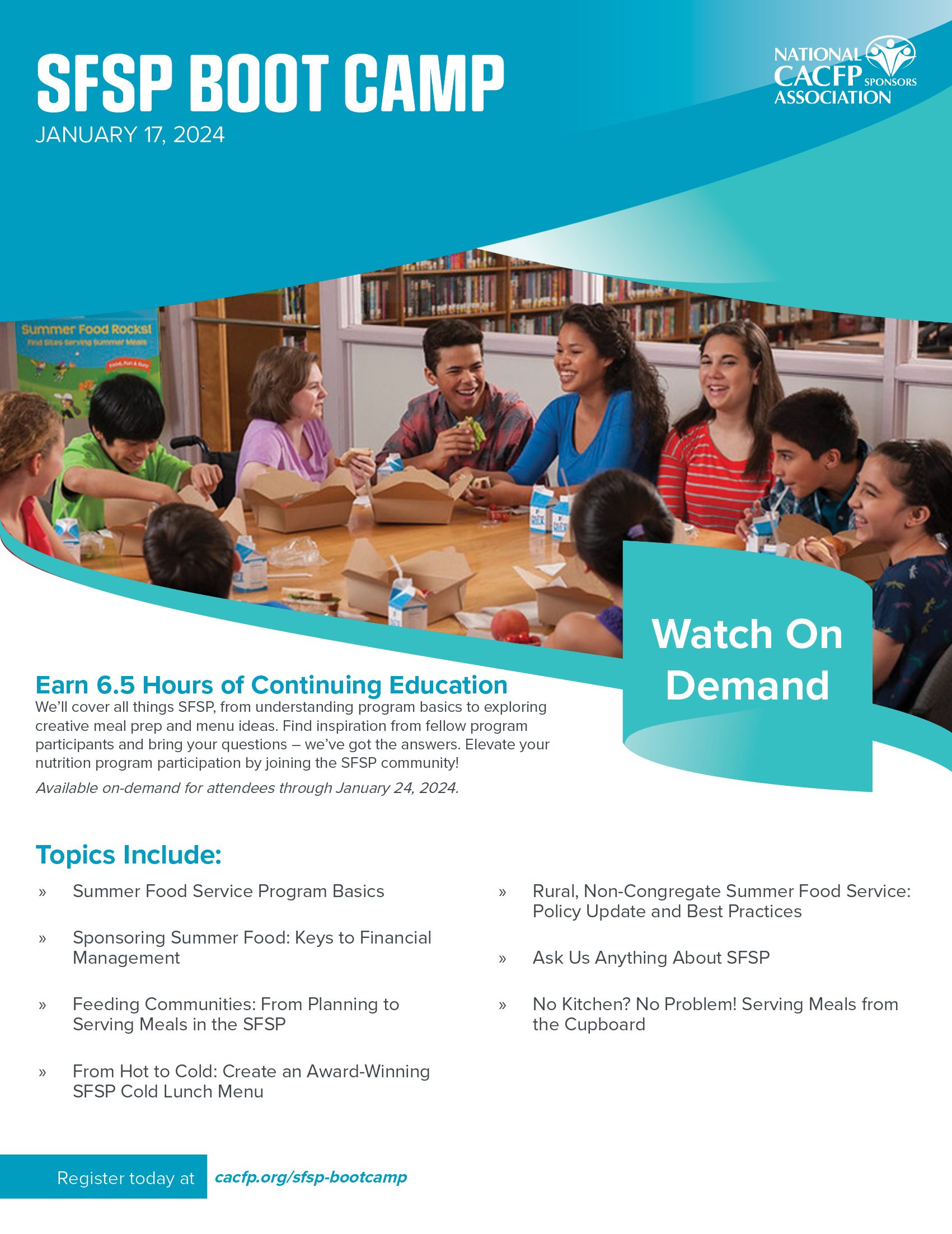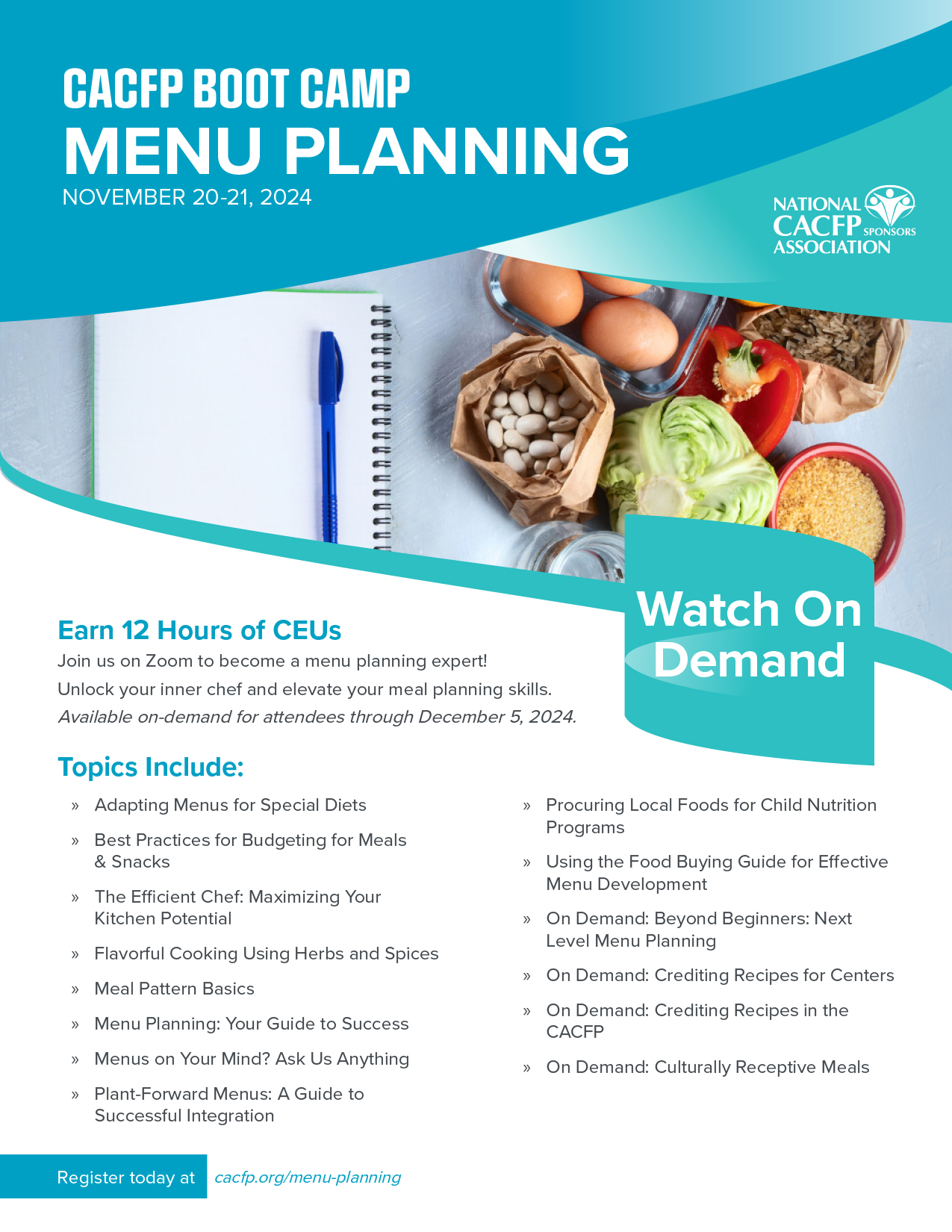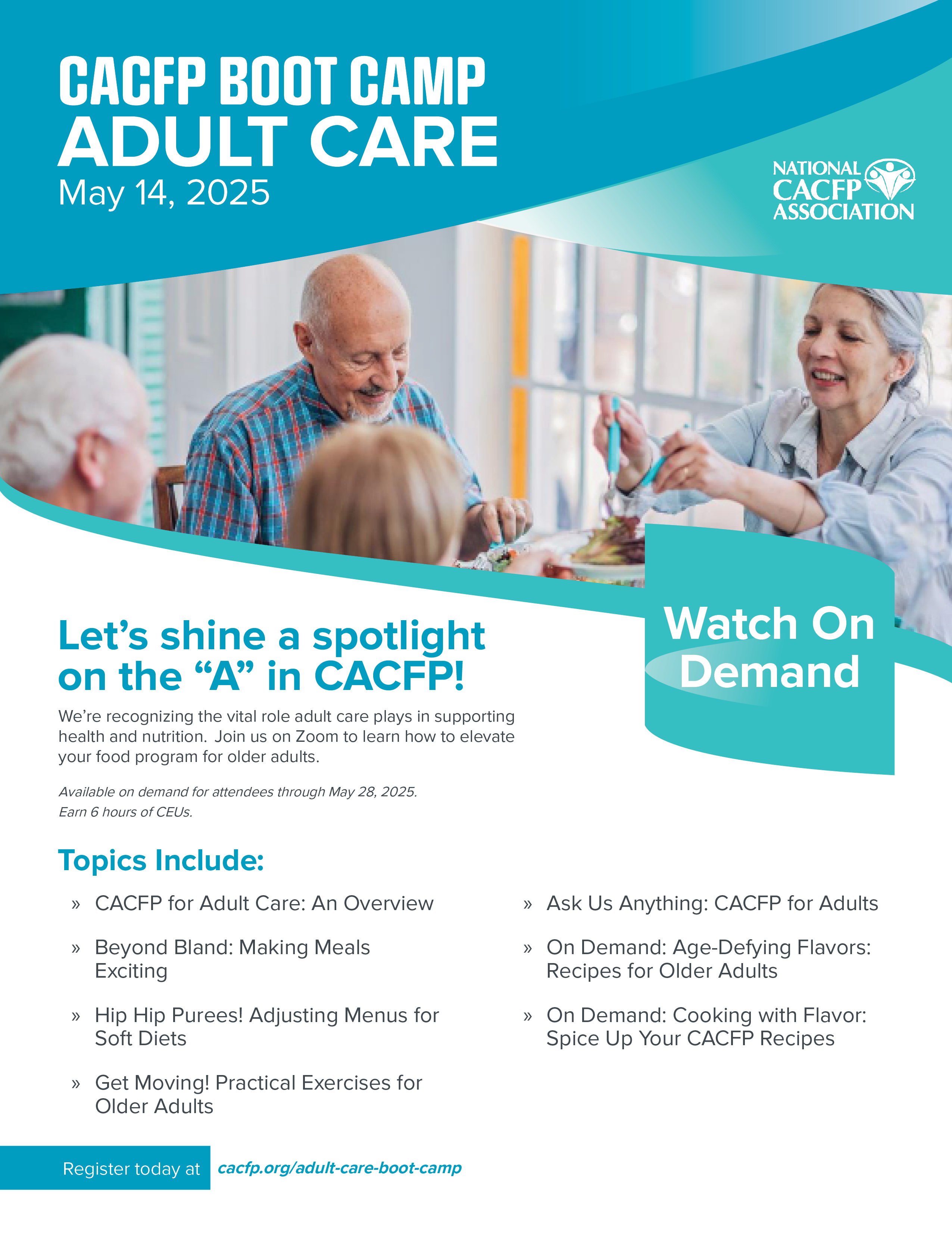
Join us on Zoom for a deep dive on some of our most popular topics in the Child and Adult Care Food Program and Meal Patterns! We develop new Boot Camps regularly, so keep checking back for what's coming up next.
Past Boot Camps Available On Demand
Obtain a broad overview about dietary needs of individuals with swallowing impairment. Receive information on the various types of texture-modified diets to safely feed individuals.
Learn how to adjust your menu when a participant has a dairy allergy. Receive training on how to identify foods containing dairy, how to modify recipes, and what dairy products can be replaced to meet the fluid milk component.
Learn the differences between various types of special diets and how to prepare these foods to meet CACFP guidelines.
You’ve learned about how to modify meals based on special dietary requests; now see how it’s done! Join us in this half hour cooking session where you will get recipes using these meal modifications.
Develop an understanding about the differences between wheat and gluten meal modifications. Learn how to identify food products containing wheat or gluten. Receive recipe ideas that will help you adapt and modify your menus.
Sodium plays an essential role in our body but consuming too much can cause us harm over time. In the CACFP, it is recommended to serve foods low in sodium. Learn about the the impacts of sodium and how to reduce sodium while still retaining flavor in the meals you serve.
Operating CACFP in Head Start is a requirement, but do you know the differences between what’s a CACFP regulation and what is mandated by Head Start? Learn what the Head Start performance standards that govern child nutrition are and how they align with the CACFP to provide good nutrition to children. Gain an understanding of the requirements and hear about the latest updates in Head Start performance standards for child nutrition.
The pandemic taught us to always be one step ahead and prepared for the unknown. Discover ways to integrate emergency preparedness and planning into your facility operation plans while including all departments. Practice writing your own emergency plans to support your program and outline your next steps.
Early Head Start sites must often manage two different meal patterns when complying with CACFP requirements based on the age of the children in their care. Learn the differences between feeding infants and toddlers to ensure optimal nutrition and program compliance. Gain valuable insights on how to create balanced and age-appropriate menus, address specific dietary considerations for infants, and implement practical strategies for promoting healthy eating habits to foster a positive mealtime environment.
Unlock a world of learning opportunities during meal times in Head Start sites through Family Style dining. Equip your staff or team with a deep understanding of the performance regulations surrounding this meal service model, empowering them to create enriching experiences. Discover how to seamlessly incorporate Math, Science, Language, and Literacy into meal times, transforming them into valuable educational moments. Get practical guidance on aligning meal service with academic goals while ensuring compliance with CACFP and Head Start regulations.
Coordination and muscle control are key skills infants need to be ready to eat solid foods, but what are the signs and resources you need to help you know? Having parents part of the conversation on what their baby is eating at child care can help bridge the gap between healthy eating practices at home and at child care.
If you are caring for infants at your site, you know there are additional requirements when feeding infants which change as they move from 0-5 months of age to 6-12 months. There are also many resources! Learn how to use and reference the USDA’s Feeding Infant Guide to support your care, protocols, and participation in the food program.
Breastmilk and formula are both creditable in the CACFP infant meal pattern. Learn what formulas are reimbursable, how to store formula and breastmilk, and how to develop a breastfeeding friendly environment at your center or family child care home.
From purees to bite-sized foods, new recipes to add to your menu are always in demand. Explore infant-friendly recipes that will not only bring something exciting to the plate, but more flavors and vegetables to be explored by those in your care!
Food allergies can arise at any age, even in infancy! Learn the nine major food allergens, how to identify foods containing these allergens and questions you may need to ask to serve meals safely for the infant(s) in your care.
The internet is abuzz with various approaches to introducing solid foods to infants, but which methods are the safest? Understand the distinctions between feeding styles, such as conventional or baby led weaning. Gain insights into how to ensure the safety of the foods you offer, implement responsive feeding practices, and prevent choking hazards.
You’re already working the food program and are ready to expand to summer feeding. Hear about best practices to ensure proper internal controls for successful financial management and mitigate high risk program areas. Identify key SFSP Financial Management Requirements. Discover strategies for existing programs to include SFSP. Acquire best practices to prevent common internal control weaknesses.
When school ends and summer begins, students who live in rural areas often experience food insecurity and sometimes have no access to healthy foods at all. Schools or parks may be up to an hour or more away from where they live and parents or caregivers simply can’t get them to SFSP sites. Learn how real programs adopted this meal service option for rural areas to better serve their community and feed hungry kids. We’ll also cover an overview of the latest policy updates, such as the recently released Interim Rule for Non-Congregate Feeding option.
Cold meals can be high-quality, healthy and reach children in a variety of non-traditional settings. Learn how to work with key community partners to bring cold meals to the Summer Food Service Program. Presented by a 2017 Silver and 2018 Gold USDA Turnip the Beet award winner.
What does it take to feed children over the summer months? A lot of preparation comes before launching SFSP. Uncover the month-by-month tasks that will help you be successful in implementing SFSP from reaching out to previous sites to bidding to paperwork and so much more!
Older adults in your care may require special considerations when menu planning in the CACFP. Learn ways to make menus more exciting and appetizing for your participants while meeting CACFP requirements.
Want to make the most of the CACFP for older adults? Let’s start with the basics! We will guide you through the eligibility criteria for older adults to receive reimbursable meals through the CACFP and provide a review of the CACFP meal pattern.
Staying active is one of the best ways to maintain health and independence, especially as we age. This session will explore simple, effective exercises that fit seamlessly into daily routines, whether at home or in an adult day care setting.
Grains are a key part of the CACFP meal pattern, providing the energy kids need to learn, play and grow. From whole grain-rich bread to pasta, knowing what counts and how much to serve is essential for meeting meal pattern requirements.
Milk is a star player in the CACFP meal pattern. It’s required at breakfast, lunch and supper—and may even make a guest appearance at snack. This nutrient-rich beverage provides essential nutrients that support healthy growth and development in children.
Vegetables provide essential vitamins, minerals and fiber to support growing bodies. But getting kids excited about eating them? That’s where strategy and creativity come in. We’ll focus on practical, easy-to-implement ways to serve vegetables in the CACFP meal pattern.
Discover how to enhance your CACFP menu planning by integrating fresh, locally sourced foods into nutritious and appealing meals. Learn smart strategies for menu development, seasonal planning, and creative ingredient swaps that make the most of local grains, meats, eggs, dairy, fruits, and vegetables.
Discover how to leverage CACFP reimbursement and State support for Farm to CACFP. Learn about allowable costs, reimbursement rules and how to apply geographic preference when sourcing local foods. Hear about effective strategies, State strategies and gather ideas on how to collaborate for success.
Learn how to identify, purchase, and serve farmers’ market finds so that the children and adults you serve can enjoy fresh flavors of the season.
Farm to ECE enhances community access to healthy and local foods by changing food purchasing practices, elevating food and agricultural education, and strengthening local food economies. Explore the National Farm to School Network’s role in supporting ECE programs, steps for connecting with local producers for procurement and innovative approaches to food purchasing.
Nutrition and agriculture education represent one of the three core elements of Farm to ECE. Explore fun and engaging activity ideas along with best practices for bringing food-based learning into your early childhood program. Discover free resources to help you implement these hands-on learning experiences with ease.
Let’s kick things off with a deep dive into the Farm to CACFP movement. Learn how connecting local farms to child and adult care programs supports nutrition, education and local economies. Hear inspiring success stories and receive a roadmap for getting started.
We’re bringing together voices from the field to share how Farm to CACFP works in real-world settings. Hear from a provider, sponsoring organization, and State agency as they discuss their journeys, challenges, and best practices for implementing and sustaining local food efforts. Listen to practical insights and inspiring stories to help you grow your own Farm to CACFP operation.

